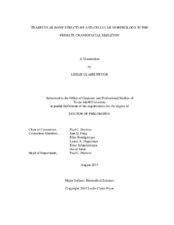| dc.description.abstract | The primate craniofacial skeleton is complex and highly variable across species. Assessing the variation of gross bone morphometry and orientation and cell microstructure in the low strain browridge and the high strain zygoma between species can aid in our understanding of craniofacial adaptation and evolution. In this study, μCT was used to characterize the trabecular bone morphology and primary trabecular orientation in the browridge of 8 humans, 5 Pan, 7 Cebus, 4 Papio, and 1 Gorilla and the zygoma of 10 humans and 5 Pan. Orientation of trabeculae in each region were compared to primary strain orientations in browridge and zygoma trabecular regions of 4 Pan finite element cranial models. Three dimensional images of the osteocytic network within high strain (anterior zygomatic root) and low strain (supraorbit) cortical regions of human and chimpanzee bone study were created using FITC staining and confocal microscopy. Quantification of osteonal osteocyte cell body shape and was carried out using Imaris Software. It was hypothesized that trabecular orientation and morphometry would be reflective of strain patters observed in Pan finite element models during premolar and molar biting. The results found that trabecular bone in the supraorbital browridge does not lie along primary strain orientations, but instead is composed of dense, sagittally oriented plates, that may serve to protect the eyes and brain from facial assaults. Trabecular bone morphometry in the body of the zygoma was orthotropic and primarily oriented in a medio-lateral direction, demonstrating a more predictable pattern of trabecular bone morphometry, anisotropy, and orientation. It was predicted that osteocytes in the supraorbital regions of both species will be significantly more oblate, spherically shaped, and smaller with shorter, thicker dendritic processes relative to osteocytes in the zygoma. Imaris analysis of osteocyte shape in the anterior root of the zygoma and the supraorbit found that human osteocytes in the supraorbit are significantly less oblate and spherical than those in the robust Pan supraorbital region and osteocytes in the Pan supraorbit are significantly more oblate than osteocytes in the Pan zygoma. In addition to offering a mechanistic explanation for systemic differences between humans and Pan, these results provide a mechanism of bone adaption that is consistent with studies that show that the low strained supraorbital region demonstrates greater sensitivity to changes in orofacial function. | en |


